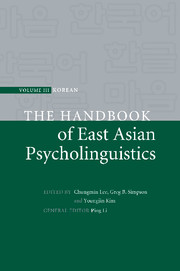Book contents
- Frontmatter
- Contents
- List of figures
- List of tables
- List of contributors
- Preface
- Introduction: Advances in Korean psycholinguistics
- Part I Language acquisition
- Part II Language processing
- 28 Visual processing of Hangul, the Korean script
- 29 English vowel spaces produced and perceived by Americans and Koreans
- 30 Morphological representation and processing of Sino-Korean words
- 31 The role of phonology in word recognition of Korean Hangul and Hanja
- 32 Lexical and sublexical processes in Korean word recognition
- 33 Prosody in sentence processing
- 34 Korean sentence processing
- 35 Sentence processing and memory representation in Korean
- 36 Understanding complex sentences: memory constraints and informational structure
- 37 ERP studies of Korean language processing: word-order effects
- 38 Inferences during discourse comprehension in Korean
- 39 Morpho-syntactic processing in Korean aphasics
- 40 Morpho-syntactic processing of Korean-speaking adults with Broca's aphasia
- 41 Comprehension deficits in Korean agrammatic aphasia
- 42 Developmental reading disorders in Korean
- 43 Individual differences in Korean language processing: context-dependent processing of skilled readers in word ambiguity resolution
- 44 A computational model of lexical and morphological processing in Korean
- References
- Name index
- Subject index
29 - English vowel spaces produced and perceived by Americans and Koreans
from Part II - Language processing
Published online by Cambridge University Press: 05 June 2012
- Frontmatter
- Contents
- List of figures
- List of tables
- List of contributors
- Preface
- Introduction: Advances in Korean psycholinguistics
- Part I Language acquisition
- Part II Language processing
- 28 Visual processing of Hangul, the Korean script
- 29 English vowel spaces produced and perceived by Americans and Koreans
- 30 Morphological representation and processing of Sino-Korean words
- 31 The role of phonology in word recognition of Korean Hangul and Hanja
- 32 Lexical and sublexical processes in Korean word recognition
- 33 Prosody in sentence processing
- 34 Korean sentence processing
- 35 Sentence processing and memory representation in Korean
- 36 Understanding complex sentences: memory constraints and informational structure
- 37 ERP studies of Korean language processing: word-order effects
- 38 Inferences during discourse comprehension in Korean
- 39 Morpho-syntactic processing in Korean aphasics
- 40 Morpho-syntactic processing of Korean-speaking adults with Broca's aphasia
- 41 Comprehension deficits in Korean agrammatic aphasia
- 42 Developmental reading disorders in Korean
- 43 Individual differences in Korean language processing: context-dependent processing of skilled readers in word ambiguity resolution
- 44 A computational model of lexical and morphological processing in Korean
- References
- Name index
- Subject index
Summary
Abstract
The aim of this paper is to examine English vowel spaces produced and perceived by Americans and Koreans, and to observe any similarities and differences among them in light of perceptual contrast in order to lead to further research on appropriate auditory scales. The paper will review speaker variation focused on non-linguistic factors, normalization methods, and then move on to competing theories of speech production and perception. Finally, the paper illustrates how Americans and Koreans perceive the synthesized English vowels followed by a discussion on the production data of B. Yang (1996).
Speaker variation
Speech signals vary greatly between and within speakers. In real life, a speaker does not produce a word in physically the same way on two occasions or in two different contexts. Furthermore, no two speakers will produce a word in exactly the same way articulatorily or acoustically. Therefore, the phonetic measurements of vowels from two different speaker or language populations may include too much speaker variation, which often leads to invalid inference.
Traunmüller (1988) divided the source of speaker variation into two factors: (1) linguistic factors such as dialectal, sociolectal differences and (2) non-linguistic factors such as physical anatomy, age, gender, and the emotional state of the speaker. Speakers also adapt their speech output depending on the listener or the environment (Lindblom & Engstrand, 1989).
- Type
- Chapter
- Information
- The Handbook of East Asian Psycholinguistics , pp. 390 - 397Publisher: Cambridge University PressPrint publication year: 2009



